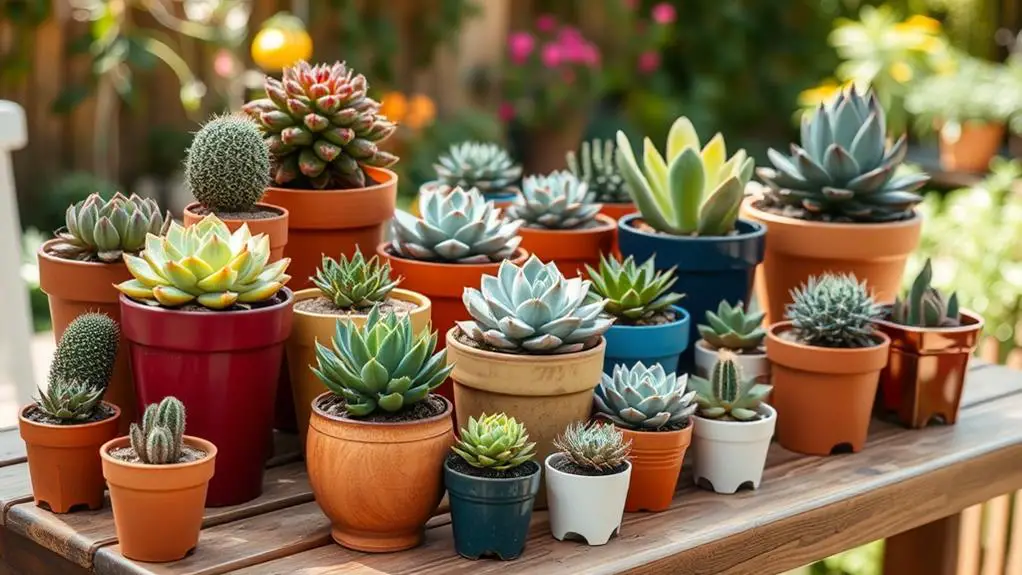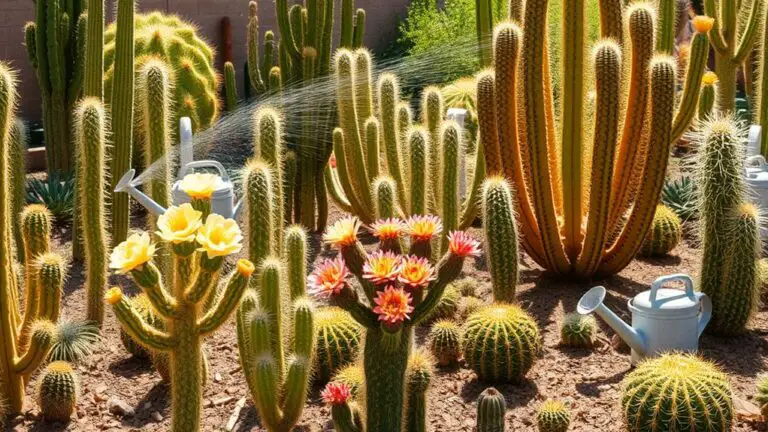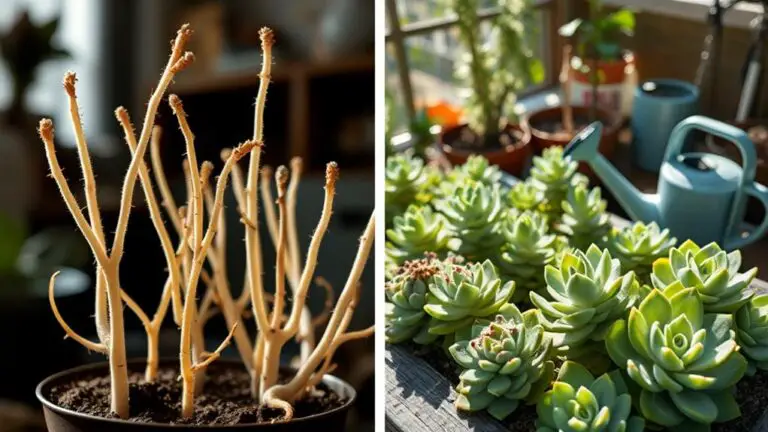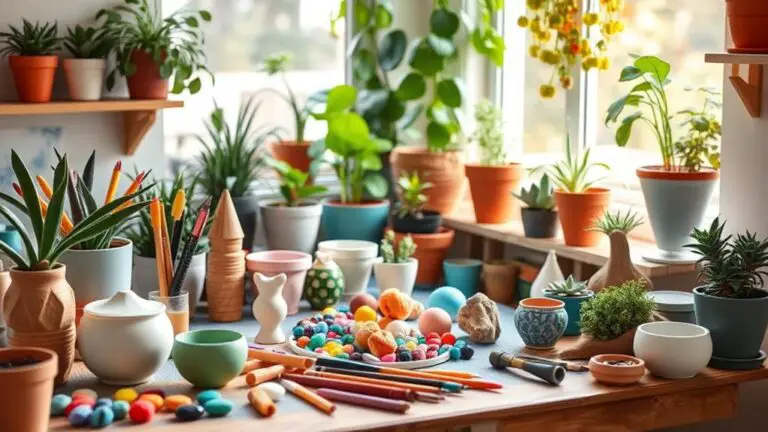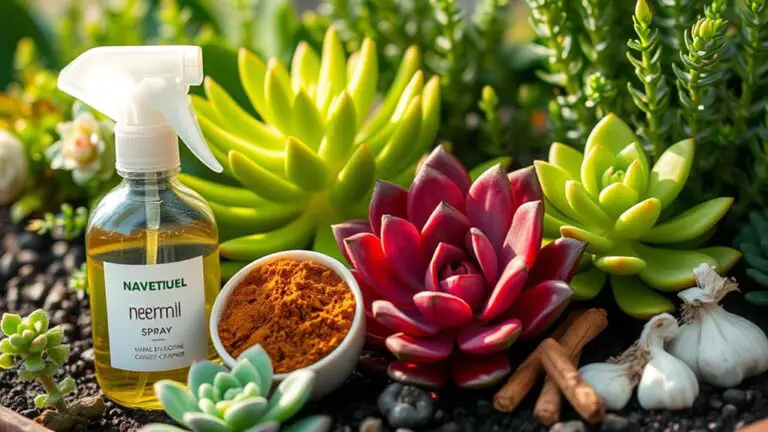8 Tips for Choosing the Right Size Pot for Your Succulents
Choosing the right size pot for your succulents can make all the difference in their health and growth. You'll want to start by understanding why pot size matters and how it affects water retention and root development. Have you ever noticed your succulents struggling despite regular care? The issue might lie in the pot's depth or diameter. Ensuring proper drainage and selecting the right material also play vital roles. Curious about how to balance aesthetics with functionality, or how to monitor growth effectively? Let's explore these key tips to keep your succulents thriving.
Understand Pot Size Importance
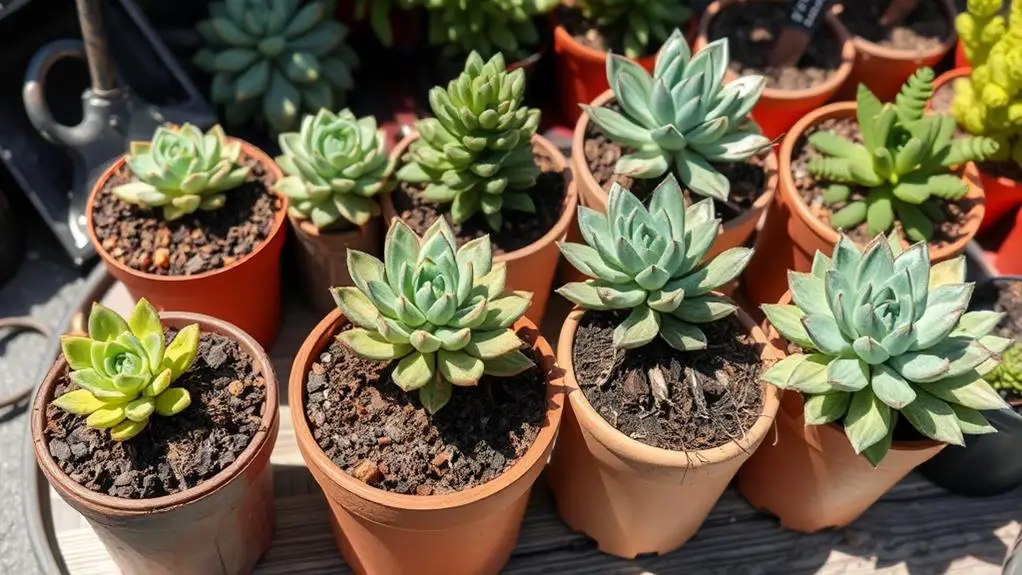
Understanding the importance of pot size is essential for maintaining healthy succulents. Choosing the right pot size guarantees your succulents have enough space for root growth, which helps them access nutrients efficiently.
A pot that's about 10% larger than your succulent's width is ideal. This promotes ideal growth and prevents overcrowding.
Pot depth matters too; shallow-rooted succulents like Echeveria need pots 2-4 inches deep, while deep-rooted types like Agave require deeper containers.
Always use pots with drainage holes. Proper drainage prevents stagnant water, which can cause root rot and other health issues.
Consider Water Retention
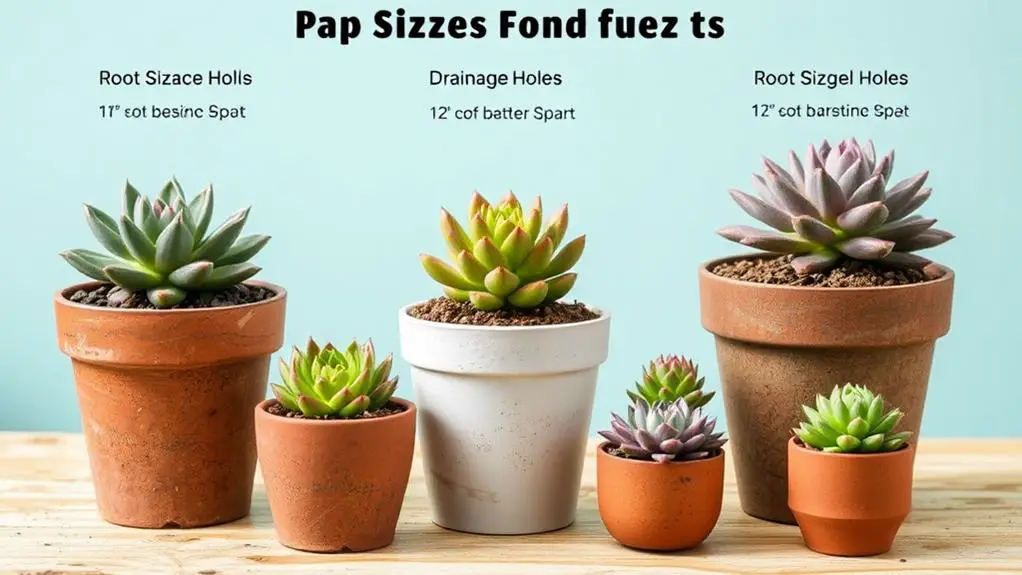
When picking a pot for your succulents, think about how much water the soil will hold.
Larger pots can lead to too much moisture, risking root rot, while smaller pots help balance water retention and promote healthy root growth.
Choosing the right size means your succulent's roots won't sit in damp soil, keeping them healthy and thriving.
Balance Soil Volume
Picking the right pot size for your succulents boils down to getting the balance just right between soil volume and water retention.
To choose the right size, you need to find the perfect pot size that allows enough soil without holding excess moisture. This balance is essential for plant health.
Succulent growers often recommend a pot about 10% larger in diameter than your succulent's width. This helps balance soil volume and guarantees proper drainage.
Too much soil can lead to overwatering, while too little can stunt growth. A well-chosen pot encourages roots to engage with the container walls, promoting healthier roots and efficient moisture absorption.
Securing this balance will help your succulents thrive.
Prevent Root Rot
Ensuring your succulents don't suffer from root rot hinges on managing water retention effectively.
To choose the perfect pot, consider using small pots that encourage roots to interact with the container walls, promoting healthy plant growth. Opt for a pot size that's about 10% larger than your succulent's width. This balance helps prevent excessive moisture retention, which can lead to root rot.
Always select pots with proper drainage holes to allow excess water to escape, reducing the risk of moisture accumulation. Regularly check the soil moisture levels in your pots to spot overwatering issues early.
Evaluate Pot Depth
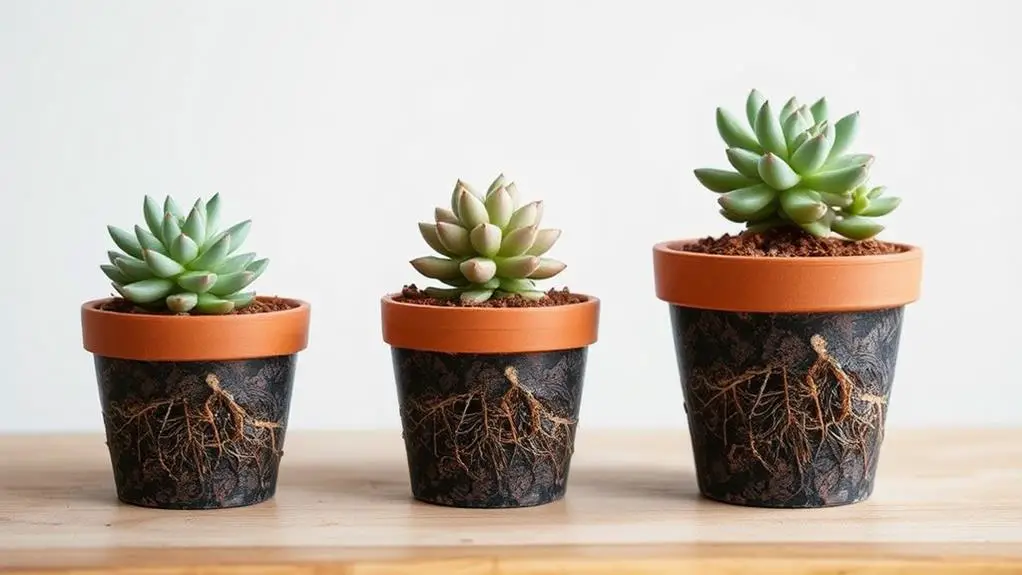
When choosing the right pot depth for your succulents, balance is key.
Shallow-rooted succulents like Echeveria do well in 2-4 inch pots, while trailing types like String of Pearls need 6-8 inches to support their root systems.
Balance Depth and Moisture
Finding the right pot depth for your succulents is crucial to their health and growth. You want a pot depth that supports drainage and moisture control. Shallow-rooted succulents, like Echeveria and Sempervivum, need 2-4 inch deep pots. Trailing varieties, such as String of Pearls, thrive in 6-8 inch deep pots. Proper pot depth guarantees your succulents' root system gets enough space to absorb nutrients while preventing water from accumulating and harming the roots. It also stabilizes the plant and keeps it looking good.
Here's a handy reference:
| Succulent Type | Recommended Pot Depth | Benefits |
|---|---|---|
| Echeveria | 2-4 inches | Stability, drainage |
| Sempervivum | 2-4 inches | Moisture control, health |
| String of Pearls | 6-8 inches | Nutrient absorption |
| Trailing Varieties | 6-8 inches | Supports root growth |
| Shallow-rooted | 2-4 inches | Enhances aesthetics |
Choose wisely to keep your succulents flourishing!
Consider Root Structure
Understanding the root structure of your succulents is key to selecting the right pot depth.
Shallow-rooted succulents, like Echeveria and Sempervivum, need a pot that's 2-4 inches deep. This allows their minimal root systems to thrive.
For trailing or upright succulents, such as String of Pearls and Aeoniums, pots that are 6-8 inches deep are best for proper vertical root growth.
Deep pots suit succulents with taproots like Agave and Aloe, supporting their robust root systems.
When you choose a pot with the right depth, it enhances plant stability and aesthetics, ensuring they don't topple.
Proper drainage and moisture retention are also essential for the overall health of your succulents.
Determine Correct Diameter
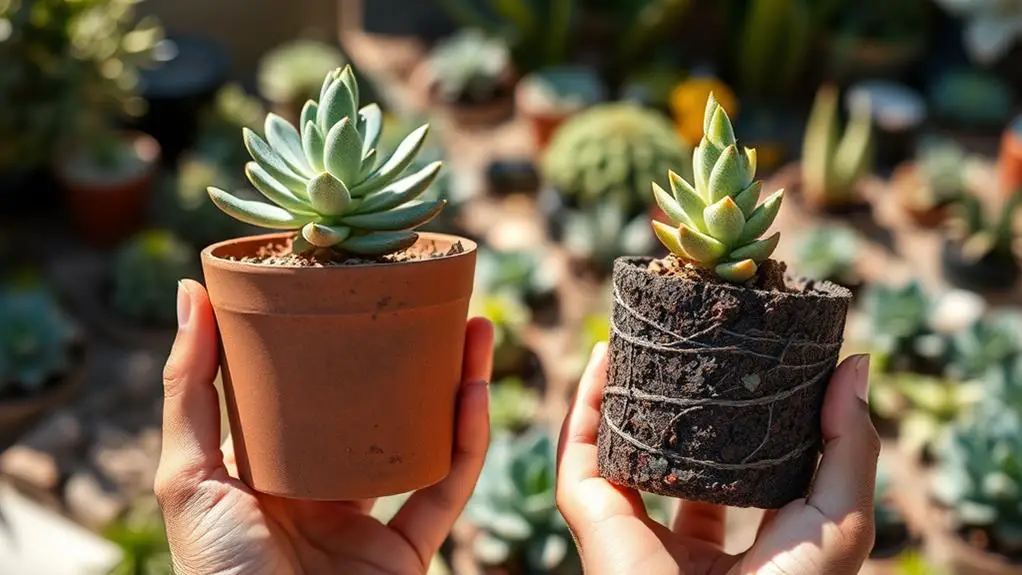
To determine the correct diameter for your succulent pot, start by measuring the widest point of your plant and choosing a pot that's about 10% larger.
For example, if your succulent is 4 inches wide, pick a pot with a diameter of about 4.5 inches. This extra space helps your succulents' roots grow properly and prevents them from getting cramped.
Fast-growing succulents like Aeonium and Echeveria might need even more room—up to 50% larger pots—to support their rapid growth.
Always verify there's about 1 inch of space between the plant and the pot edges for good airflow.
If you're planting multiple succulents together, make sure the pot is 10% larger than the combined width of all plants.
Check Drainage Holes
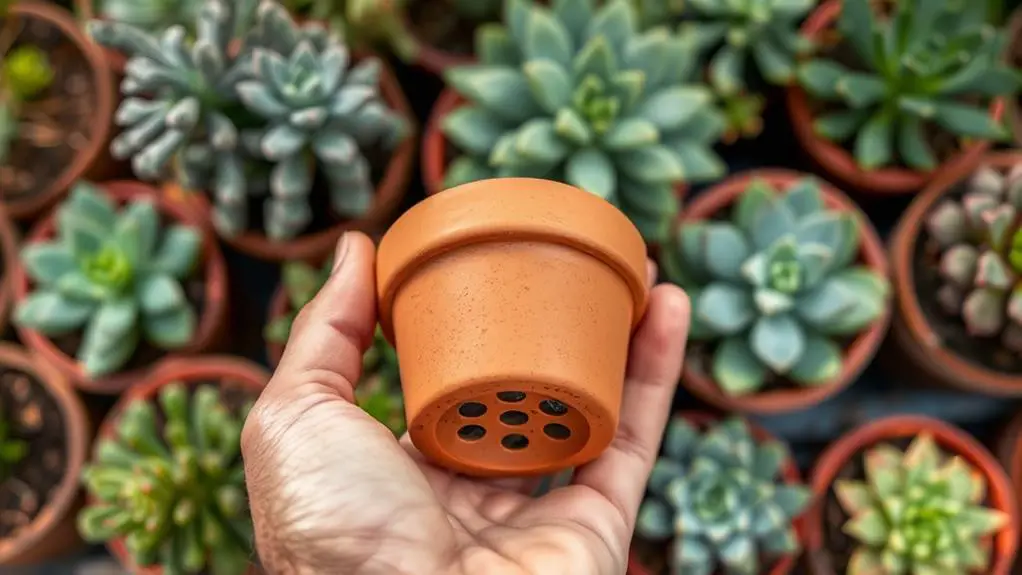
Proper drainage is essential for healthy succulents, so make certain your pot has drainage holes. Succulents need well-draining conditions to thrive and avoid root rot. When choosing the perfect pot, look for those designed with drainage systems to prevent overwatering. Regularly check the drainage holes for clogs caused by soil or debris. If you're using pots without drainage holes, adding a layer of gravel at the bottom can help, but it's riskier for your succulents' health as it may still retain moisture.
| Tip | Importance |
|---|---|
| Ensure drainage holes | Prevents root rot |
| Regularly check for clogs | Maintains proper water flow |
| Avoid pots that retain moisture | Supports well-draining conditions |
| Use pots with drainage systems | Ideal for beginner succulent care |
Select Appropriate Material
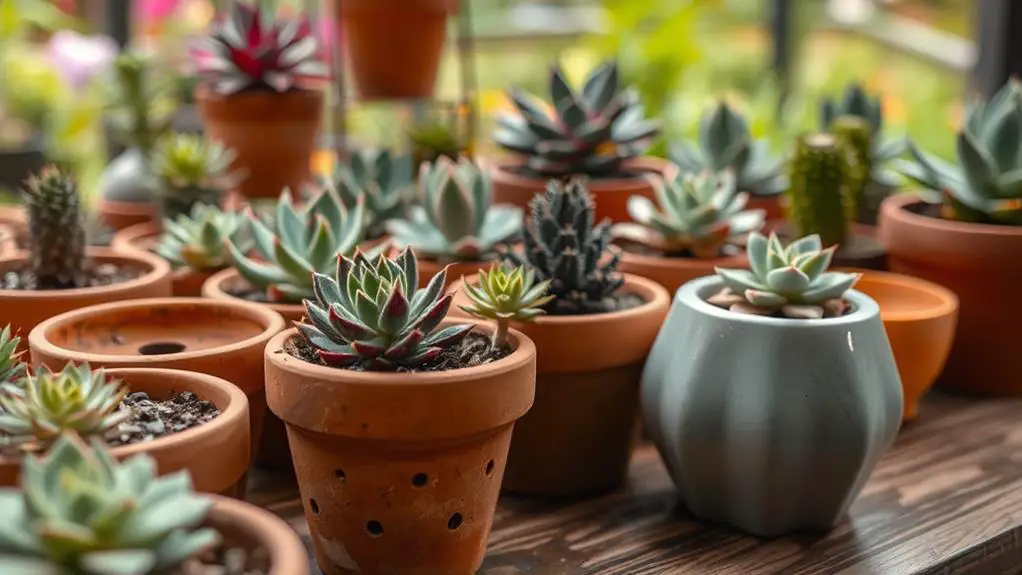
After confirming your pot has proper drainage, it's important to contemplate the material of the pot you choose for your succulents.
Terracotta and ceramic pots are fantastic because they're breathable, allowing moisture to evaporate and promoting healthy root growth. This reduces the risk of root rot.
Plastic pots, while lightweight and affordable, don't offer great drainage and airflow, which can cause moisture retention issues.
Metal pots look stylish but can heat up quickly in the sun, stressing your succulents. If you use metal, keep them out of direct sunlight.
Wooden containers retain moisture well but need good airflow to prevent rot.
Always confirm your chosen pot has adequate drainage holes to support your succulent's health.
Balance Aesthetics and Function
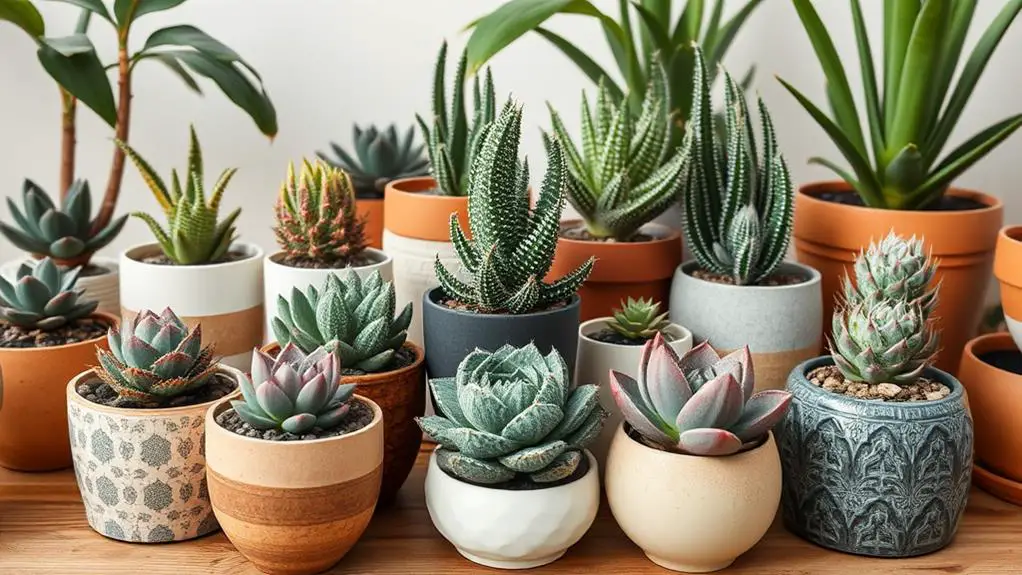
Striking the right balance between aesthetics and function is essential when choosing a pot for your succulents. You'll want to select pots that complement your succulent's color and texture, enhancing their visual appeal.
However, don't forget about functionality. Choose pots with proper drainage to prevent excess moisture from damaging the roots. For ideal growth, aim for a pot size that's about 10% larger than the succulent's widest point.
Experiment with materials like terracotta for breathability or ceramic for style. Grouping containers of varying heights and colors can create an interesting display while ensuring each plant has enough space.
Monitor Growth and Health
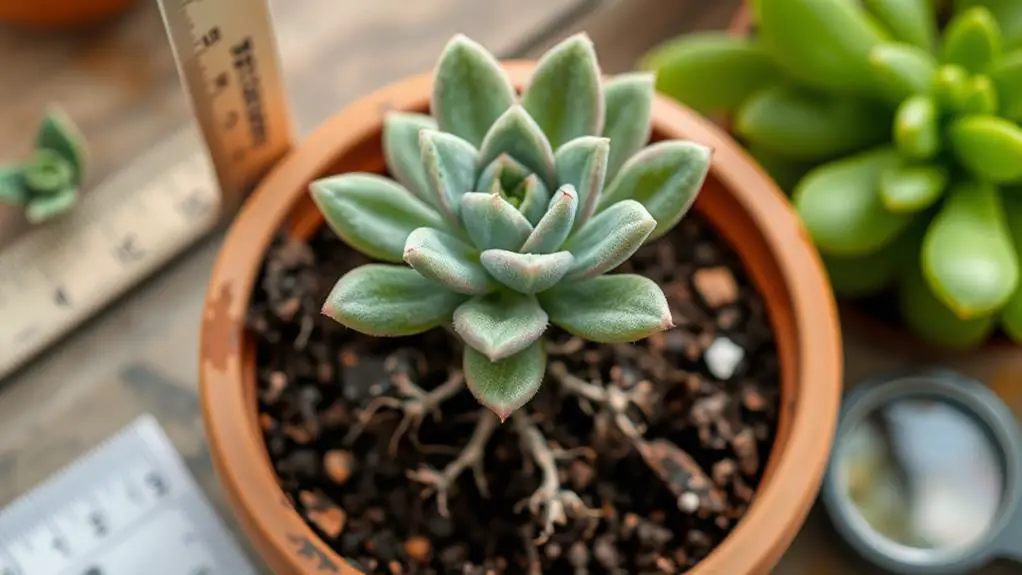
While balancing aesthetics and functionality is important, keeping an eye on your succulent's growth and health is equally essential. Regularly monitor growth and check for stunted development.
If your succulent seems cramped, it might need a bigger pot to support healthy root development. Also, observe the moisture levels in the soil; if it stays damp too long, the pot size might be too large, risking overwatering and root rot.
During repotting, inspect the roots—healthy ones show some growth. If they're tightly bound, it's time for a larger pot.
Notice if your succulents look leggy; this could mean they're not getting enough light, often due to overcrowding. Fast-growing succulents may need frequent repotting to keep up with their pace.
Frequently Asked Questions
How to Choose Pot Size for Succulents?
Choose a pot that's 10% larger than your succulent's widest point. Confirm it has drainage holes. For deeper roots, pick a deeper pot. Maintain space between multiple plants for airflow. Avoid overly large pots to prevent overwatering.
What Is the Best Pot for a Succulent?
You should choose a pot that's about 10% larger in diameter than your succulent. Make certain it has drainage holes and isn't too deep to prevent root rot. Leave half an inch of space for airflow and avoid overcrowding.
How Do I Know if My Succulent Needs a Bigger Pot?
You'll know your succulent needs a bigger pot if you see roots growing out of drainage holes, stunted growth, quick-drying soil, top-heaviness, or yellowing leaves. These signs indicate it's time to repot for better growth.
Do Succulents Prefer Smaller Pots?
Yes, succulents prefer smaller pots because they limit excess soil, which encourages root growth. However, don't go too small; choose a pot about 10% larger than the plant's width to avoid root-bound conditions and guarantee healthy development.
Conclusion
You've got this! By following these tips, picking the right pot for your succulents becomes a breeze. Remember to choose a pot that's just a bit bigger than your plant, consider the depth needed, and always check for drainage holes. Keep an eye on your succulents' growth and health, and you'll create a perfect home for them. With a little attention and care, your succulents will thrive and bring joy to your space. Happy gardening!

